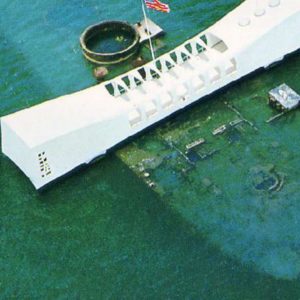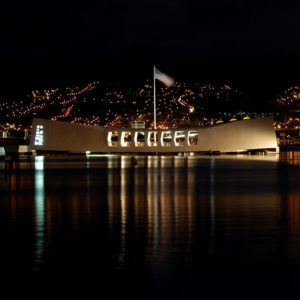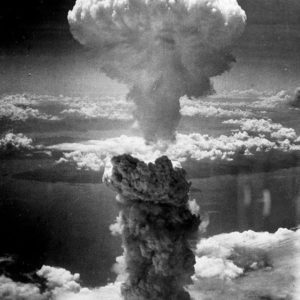- Currently, there is a memorial museum on the USS Arizona on the island of Oahu that remembers the American soldiers that died during the attack, with only five remaining survivors of the USS Arizona. Visitors need to take a boat from the naval base in Pearl Harbor. Source: @MaryG0401
- Every year on Dec. 7, Americans honor the attack that killed and injured many people. In many places across the country the flag gets lowered to honor the fallen soldiers. Source: Wikicommons
- The atomic bombing on the Japanese city of Nagasaki on August 9, 1945 produced a mushroom cloud rising to about 11 miles. Source: @WarHistoryOL
- American aircraft defense in Pearl Harbor in 1941 twitter: @ww2albert
By Niclas Bez
On Dec. 7, 1941, Americans and people around the world were affected by the attack on Pearl Harbor. On this day, the Imperial Japanese Navy executed a massive military strike on the Pearl Harbor United States naval base that was known as Operation Z. This attack led the United States of America to join World War II.
Prior to the attack the United States seized all oil exports to Japan in July of 1941 to stop Japan’s military dominance in East Asia. In addition, the American military fleet was moved from the base in San Diego to Pearl Harbor, Hawaii, while forces were built up on U.S. military bases in the Philippines. With these strategic moves, the United States was the only thing that kept Japan its conquests of Asia.
In order to maintain their military actions in the Pacific, the Japanese military prepared the massive strike throughout 1941 that was planned for Dec. 7. On this day, the Japanese attacked U.S. bases in Pearl Harbor, the Philippines, Guam, and Wake Island. On top of that, they also had air strikes against bases of the British Empire in Malaya, Singapore, and Hong Kong.
Overnight, the Japanese moved six aircraft carriers 200 miles north of the island of Oahu to be in striking distance. Then, at the morning of Dec. 7, a total of 353 Japanese fighter planes, bombers, and torpedo planes took off in two waves and caused massive destruction. The attack destroyed the American battleships, 188 U.S. aircraft, while 2,403 Americans got killed, and more than a thousand got wounded.
The goal with Operation Z was to show the Japanese dominance in the Pacific Ocean and East Asia. According to Japan Today, Japanese Commander Yamamoto stated that he wanted a limited war and conclude with a peace treaty after inflicting serious damage on the United States. However, this did not happen and on Dec. 8 the United States declared war on Japan, according to the Armed Force Museum’s website.
“Pearl Harbor was the event that compelled America to enter into World War II. Its impact is hard to overstate in that respect. There was growing sentiment for the United States to get involved in the allied effort, but after Pearl Harbor, it was a clear signal that the US should make the formal step to enter into the fray,” said Frank Orlando, politics science professor.
President Franklin D. Roosevelt asked Congress to declare war after the attack. Congress had to vote on the decision, but after Japan attacked Pearl Harbor, it was a straightforward decision.
“When the US declared war on Japan, the vote in the Senate was unanimous. The vote in the House was 388-1. The only member of Congress that voted against war was Jeannette Rankin, the first woman elected to Congress from Montana. She happened to be a pacifist, and she believed that if she couldn’t go to war, she couldn’t send others to war. The uproar over her decision was massive among the public and her fellow legislators, almost everyone else believed that the action at Pearl Harbor necessitated a reaction. Franklin D. Roosevelt called for the war resolution in his famous ‘Infamy’ speech.”
In his famous speech Roosevelt said, “Yesterday, Dec. 7, 1941, a date which will live in infamy, the United States of America was suddenly and deliberately attacked by naval and air forces of the Empire of Japan. We will gain the inevitable triumph, so help us God.”
Nine hours before the U.S. declared war, the United Kingdom declared war on Japan due the Japanese attacks on Singapore, Hong Kong, and Malaya (now Malaysia). Also, only a few days after the declaration, Germany and Italy showed their commitment to the Tripartite Pact and declared war on the United States on Dec. 11. The Pact had previously been created between Japan, Italy, and Germany in order to limit U.S. interventions on global territory that affected the three countries.
In April of 1942, the United States Air Force started with small-scale bombings on Tokyo as a part of their Pacific campaign in order to regain territories that had previously been conquered by the Japanese.
In the same year, the U.S. joined the British forces in order to reclaim the French territories in North Africa that had been conquered by Germany. The North African Campaign took until May of 1943 to reclaim Algeria, Tunisia, Libya, Morocco, and Egypt. The Americans had lost over 18,000 troops in Tunisia alone, according to the United States Holocaust Memorial Museum’s website.
It wasn’t until 1944 when the Air Force started again with strategic bombings of urban areas in Japan. This was the start of the U.S. attacks on the Japanese island. The Air Force used long-range B-29 bombers to attack Tokyo and other cities in the area. These bombings killed approximately 750,000 Japanese civilians, according to Air Force Museum.
In the same year on June 6, the British and American troops had one of the most important victories when capturing the Normandy coast line on the so-called D-Day. Throughout a 50 mile long stretch on the coast line, troops from Canada, UK, and the U.S. used amphibious landing vehicles to access the beach under heavy gunfire.
In the late evening on May 8 of 1945, the head of Nazi Germany’s armed forces signed the instrument of surrender in Berlin. It was signed with the Supreme High Command of the Red Army and U.S. and French representatives as witnesses.
While the war on the European continent was officially over, Japan refused to sign the unconditional surrender and the Pacific War continued. The Allies countries continued a firebombing campaign on Japan that destroyed 67 cities. The United States continued and dropped two nuclear bombs on Hiroshima and Nagasaki on Aug. 6 and 9 of 1945. This remains the only use of nuclear weapons in warfare history.
It took Japan until Aug. 15, six days after the bombing on Nagasaki and the Soviet declaration of war against Japan, until Japan announced its surrender. On Sept. 2, Japan signed the instrument of surrender that effectively ended World War II.
The outcome of Pearl Harbor turned out to have a huge impact in the history. The attack did not only get the United States involved in a war in the Pacific, but also on the European continent to support their allies. Many people look back at this scenario and question whether there could have been a more peaceful outcome that could have saved many lives.
“I think it’s always fun to go down the rabbit hole and think what might have been, but I think that there probably would have been some other aggressive action by Japan in the Pacific that would have gotten us involved, so instead of December 7, 1941, a different day would be living in infamy,” said Orlando.









